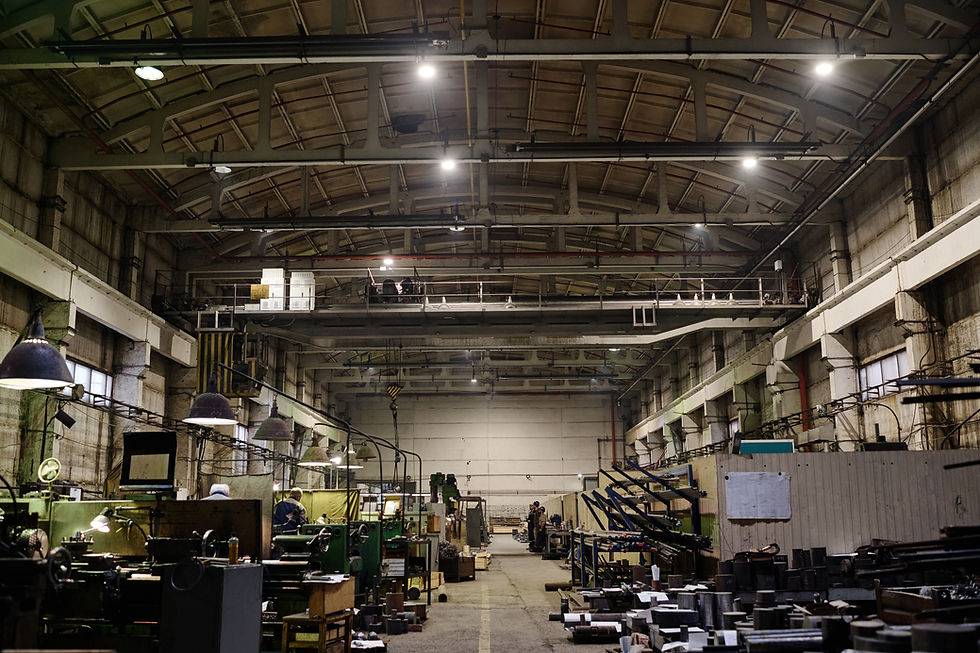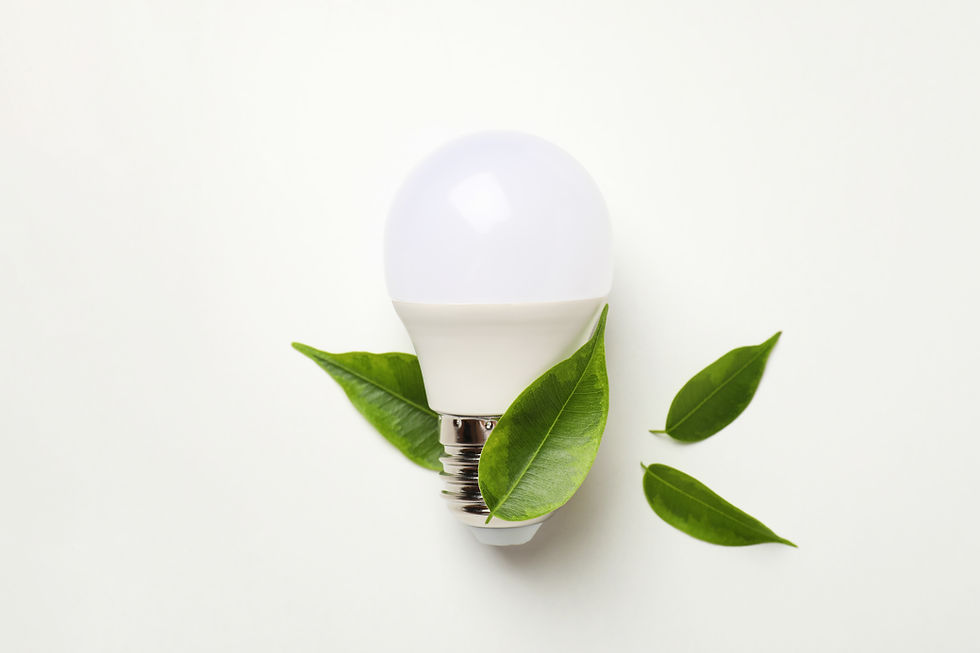Maximizing Efficiency: Industrial LED Lighting Options
- floomarktechnology
- Jul 31
- 4 min read

Industrial spaces—whether warehouses, factories, or large-scale manufacturing units—rely heavily on consistent, powerful lighting to keep operations running smoothly. But with energy costs rising and sustainability becoming a core business goal, outdated lighting systems are no longer viable. That’s where industrial LED lighting comes into play.
Switching to LED lighting isn't just about brighter lights—it's about maximizing energy efficiency, lowering operating costs, and creating safer, more productive work environments. Let’s dive into the top LED lighting options for industrial spaces and how they help improve performance and reduce overhead.
Why Industrial Facilities Are Choosing LED Lighting
Industrial facilities often operate 24/7, consuming a significant amount of energy—especially for lighting. According to the U.S. Department of Energy, lighting can account for up to 40% of an industrial facility’s energy use. That’s a huge slice of the pie.
LED lighting can cut energy use by up to 75% compared to traditional systems like metal halide, fluorescent, or incandescent. On top of that, LEDs last significantly longer—typically between 50,000 to 100,000 hours, reducing how often lights need to be replaced. For businesses managing hundreds (or even thousands) of fixtures, the savings add up quickly.
Benefits That Go Beyond Just Energy Savings
1. Reduced Maintenance Costs
LEDs don’t just last longer—they're also more reliable. This means less time spent on maintenance, fewer disruptions, and fewer replacement parts. For facilities with high ceilings or hazardous zones, this alone is a game-changer.
2. Improved Light Quality
Modern LED lights offer a high Color Rendering Index (CRI)—usually 80 or above—which means colors and details appear more accurate and vivid. This is especially important in areas where precision matters, like assembly lines or inspection stations.
3. Durability for Harsh Conditions
Industrial environments can be rough on equipment. Dust, vibration, moisture, and temperature extremes can wreak havoc on traditional lighting. LED fixtures built for industrial use often carry IP65, IP66, or even IP69K ratings, ensuring long-term performance in challenging conditions.
4. Smart Control Capabilities
Many industrial LED systems now integrate with smart controls, allowing you to automate on/off times, dim lights when areas are unoccupied, and adjust brightness based on natural daylight. These features can further reduce energy usage—often by another 20% to 30%.
Top Industrial LED Lighting Options
Choosing the right LED fixture depends on your facility layout, ceiling height, and the tasks being performed. Here are some of the most efficient options for industrial use:
High Bay LED Lights
Best for tall ceilings (typically over 20 feet), high bay lights provide powerful, uniform lighting in large spaces like warehouses and production areas. Look for fixtures with 130–150 lumens per watt (LPW) for maximum efficiency.
Low Bay LED Lights
Used in areas with lower ceilings (under 20 feet), these lights work well in workshops, packaging zones, or storage rooms. They provide focused, even lighting without excessive glare.
LED Flood Lights
Perfect for outdoor industrial spaces such as loading docks, perimeters, or storage yards. Industrial-grade flood lights are designed to be weather-resistant and provide wide-area coverage. Many models now come with motion sensors or photocells for better efficiency.
Linear LED Fixtures
Often used in corridors, production lines, or suspended from ceilings in continuous rows. These fixtures offer a clean look, consistent illumination and are often used where uniform light is critical.
Explosion-Proof LED Fixtures
For hazardous environments like chemical plants, oil refineries, or mines, Class I, Division 1 rated LED lights are essential. These fixtures are specially designed to contain sparks and prevent ignition of flammable materials.
Wall Pack and Area Lighting
Mounted on the exteriors of buildings or in parking areas, these fixtures enhance safety and visibility. Modern versions come with adjustable wattage and CCT (correlated color temperature) settings for flexibility.
How to Get the Most Efficiency From Your Lighting
Simply switching to LED is a great start, but combining LEDs with smart planning and control systems can take your savings even further:
Use Zoning: Group lighting by area and activity level. Storage zones may not need as much brightness as assembly lines.
Add Motion Sensors: Lights only turn on when people or equipment are present, cutting waste.
Incorporate Daylight Sensors: Lights dim automatically when natural light is sufficient.
Schedule Downtime Dimming: Automatically reduce brightness during breaks, weekends, or after-hours.
Incentives That Make Upgrading More Affordable
Across the U.S., many utilities offer rebates and incentive programs for businesses that upgrade to energy-efficient lighting. Programs from organizations like the DSIRE (Database of State Incentives for Renewables & Efficiency) can cover a significant portion of retrofit costs.
In some cases, facilities can also take advantage of federal tax deductions through IRS Section 179 or apply accelerated depreciation (MACRS) for energy-efficient upgrades, making the financial case even stronger.
Preparing for a Smarter, Greener Future
Industrial LED lighting is rapidly evolving. With the rise of the Internet of Things (IoT) and Industry 4.0, lighting systems are becoming more intelligent—capable of gathering data, responding in real time, and integrating with broader energy management systems.
Future-ready facilities are already adopting adaptive lighting, AI-based lighting analytics, and networked controls to monitor usage, reduce downtime, and enhance sustainability.
Conclusion
If your facility is still using outdated lighting technology, it’s time to make the switch. Industrial LED lighting isn't just about energy savings—it's about improving safety, productivity, and long-term profitability. With the right lighting strategy, businesses can cut costs, meet sustainability goals, and create a better work environment for everyone involved.
When it comes to high-performance, reliable, and efficient industrial lighting, Havells Lighting stands out as a top manufacturer in the industry. With a proven track record of delivering innovative lighting solutions built for the toughest environments, Havells helps industrial businesses across the U.S. light smarter, work safer, and operate more efficiently.
✅ SEO-Friendly FAQ Section:
Q1: Why should industrial facilities switch to LED lighting?
A: Industrial LED lighting offers up to 75% energy savings, lasts longer than traditional fixtures, reduces maintenance costs, and improves visibility and safety.
Q2: What are the best LED lighting options for warehouses?
A: High bay LED lights are ideal for warehouse environments with tall ceilings. They provide bright, uniform light and excellent energy efficiency.
Q3: Are there rebates or incentives for upgrading to LED lights?
A: Yes, many U.S. utility companies offer rebates for LED upgrades. Businesses may also qualify for tax deductions under programs like Section 179 or MACRS.
Q4: How long do industrial LED lights typically last?
A: Most industrial LED fixtures have a lifespan of 50,000 to 100,000 hours, depending on the application and environment.
Q5: What makes Havells Lighting a top industrial lighting manufacturer?
A: Havells Lighting delivers durable, energy-efficient, and performance-driven LED solutions designed specifically for demanding industrial environments across the U.S.



Comments